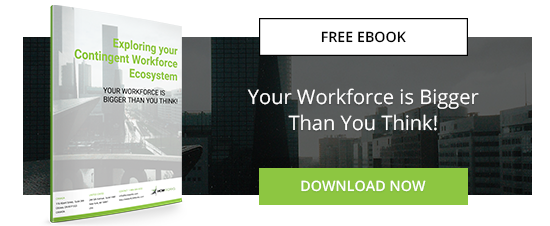The contingent workforce is expanding and becoming more visible and prominent across all types of industries, business sectors, and organizations. It’s becoming increasingly important to establish a program that will bring success, and fully realize the potential that this type of workforce can bring.
One of the best ways to set-up and manage a contingent workforce program is to outsource part of the process by leveraging the services of a specialized contingent workforce MSP (Managed Services Provider). An MSP will help develop a program that brings strategic value, and they’ll operate as an external arm of your organization.
To do this successfully, an MSP should be able to take on a consulting role in the operations of your business, while fitting seamlessly, without friction, into your management style and business culture. If the MSP becomes a true strategic partner, it can actively look across your organization for integration, optimization, and collaboration opportunities. They will seek and relate inter-department knowledge, gain data insights, and thereby provide a better ROI for you.
There are 3 major points of value that your contingent workforce MSP needs to unlock. Their ability to do so, depends on how successful they are at establishing a strategic consulting role in your organization.
1. Data Insight
Only by data mining across the entire organization can companies uncover important trends, and cost-saving opportunities. It's vital to have insight into the right metrics, such as price, time-to-fill, and successful placement. Your MSP should be able to evaluate your KPIs, recommend any changes, and produce or identify the source of the data necessary for their measurement.
A contingent workforce MSP program is most successful when you can accurately assess how well it’s doing and focus on continuous improvement. Identifying issues, finding solutions, and adapting to changes, is essential to ensure the best possible results.
One of the benefits of using a contingent workforce MSP, is that the program designed for you can be focused on your immediate goals and priorities. Are you looking to significantly reduce contingent workforce costs, establish more rigor in compliance, get better access to top talent, or improve base management? Setting priorities, goals, KPIs, will all contribute to your program’s success. You need data to establish where you are, and SMART goals to build your program around.
2. Stakeholder Buy-In
Fundamental to the success of any MSP program is full buy-in from your organization. This needs to be across the board, from HR and procurement, to finance and the remaining C-suite. Each of these stakeholder groups must be aware of the aims of the program and fully back the goals it is trying to reach.
All stakeholders should know the impact of the program. They should know: what you ultimately want to get out of your contingent workforce, what change management practices are required, and how you see this program being managed.
When this is achieved, your organization will be better aligned with the program’s vision, the program will be more effective, and less friction is likely to occur. Complete stakeholder buy-in makes it much easier to ensure the program is optimized, both in terms of scope and resources.
It's all too common for the different departments to operate in silos, and pay little consideration to anything that is not their own direct responsibility. The contingent workforce is traditionally seen as the remit of procurement, or HR, and something that can be left to these functions. However, the reality is that the performance of the contingent workforce impacts all areas of an organization, and all stakeholders should be on board with efforts to get the most out of the program.
Change management is critical to most corporate initiatives, and a contingent workforce program is no exception. How you address change management can make or break the program. Whether you are introducing a VMS or MSP program for the first time, or are on your 20th expansion, each new country/region/business unit/labor category requires the same change management process and effort.
3. Continuous Scope & Resource Evaluation
The scope and resources needed to manage a contingent workforce are prone to change because internal and external factors: changes in a company’s workforce, legislation to manage flexible staff, and product and service offerings of vendors, to name a few.
This makes it imperative to continuously re-evaluate your contingent workforce program, and reallocate resources accordingly. As we mentioned above, complete stakeholder buy-in makes it much easier to obtain approvals, and move things forward, when change makes it necessary to modify scope and resources to appropriate levels.
When the scope of your contingent workforce program is clearly defined, and the program goals are identified and agreed to with all stakeholders, then you have a roadmap for success. Your contingent workforce MSP should be your strategic partner, helping to monitor, adjust, improve, and recommend changes to keep you on track for success.



